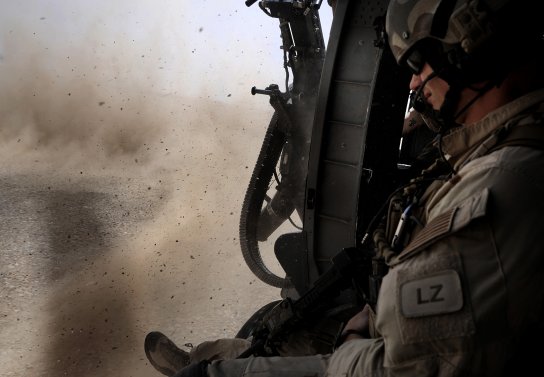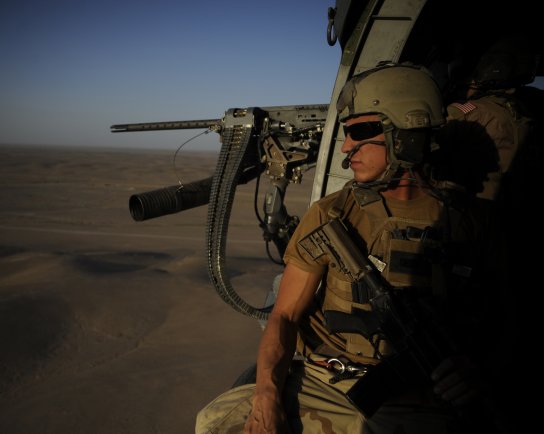
As dust kicks up from the rotor wash of an HH-60G Pave Hawk, Senior Airman Clint Lentz, pararescueman with the 129th Expeditionary Rescue Squadron, prepares for the landing June 26, Hemland province, Afghanistan. Airman Lentz and the rest of the crew are responding to a medevac request to aid personnel conducting combat operations further down range.

From the side of an HH-60G Pave Hawk, Senior Airman Noah Landwerlen, pararescueman with the 129th Expeditionary Rescue Squadron, watches for any potential dangers prior to landing June 26, Hemland province, Afghanistan. Airman Lentz and the rest of the crew are responding to a medevac request to aid personnel conducting combat operations further down range.

Staff Sgt. William Lawson, pararescueman with the 129th Expeditionary Rescue Squadron, comforts a wounded Afghan national army soldier, Hemland province, Afghanistan. Lawson will provide care to the injured soldier until they can safely deliver him to a hospital.
U.S. Air Force Rescue Aids in ‘Golden Hour’ Recovery of Coalition Forces
by Staff Sgt. Stacia Zachary
Racing against the clock, rescue flights launch into action to retrieve wounded service members and other battlefield casualties. As the helicopters hover over a hostile area, the Guardian Angel team rushes out to retrieve the wounded – often risking their own lives “so that others may live.”
The 129th Expeditionary Rescue Squadron here responds to emergency medical evacuation calls within Helmand province. The detachment covers the dual role of providing casualty evacuation and personnel recovery/combat search and rescue in the Helmand province. They support Regional Command South, responding to calls for U.S. and coalition forces as well as Afghan national security forces and local nationals.
“As Air Force rescue crews, we use our personnel recovery and combat search and rescue skill-set to conduct CASEVAC quicker and better than anyone in theater,” said Maj. Matt Wenthe, 129th ERQS detachment commander.
The rescue squadron is made up of more than 60 personnel and HH-60G Pave-Hawks. The rescue flight consists of two helicopters, each with a pilot, co-pilot, aerial gunner, flight engineer and two pararescuemen or combat rescue officers.
The Air Force rescue teams hold true to their motto: Those things we do so that others may live. They are often identified through the Jolly Green Giant patches seen worn on their right shoulders.
“Our entire mindset is to bring an emergency medical platform, combined with offensive security capability, to the site for quick and successful extraction of those who need us,” Wenthe said.
The area has recently seen an increase of insurgent activity as more coalition forces are moved into Afghanistan. As such, more calls come over the radio requesting rapid recovery of injured servicemembers, or innocent bystanders in locations that are extremely hostile. This type of mission demands a response team specialized in rapid insertion to and egress from aggressive and risky environments.
“The CSAR mission requires us to train going into hostile environments,” the major said. “That training allows us to execute medical evacuations in areas other units cannot get into.”
The rescue crews are trained to extract personnel in any environment.
“We can go into any mission-set to recover someone, regardless of the terrain,” said Capt. John, 129th ERQS CRO. “Whether they are Marines entrapped in an MRAP [mine-resistant ambush protected vehicle] or hanging from a 10,000 ft. cliff, my men can get to them and get them to safety.”
The rescue teams must remain on high alert during their 12-hour shifts. When a medical report drops, the teams need to be ready immediately.
“Things happen quick and the men have to be ready to move at a moment’s notice,” Wenthe said. “Our guys can be asleep or playing video games and 15 minutes later, flying into a hot zone recovering a seriously injured Soldier.”
As per Secretary of Defense Robert Gates, teams need to respond within 60 minutes from the time a 9-Line medical alert drops, to wheels down and transferring a patient to a higher level of medical care – a concept commonly referred to as the “Golden Hour.”
“Speed is what’s saving lives,” the major said. “Getting the Soldiers who are injured picked up quickly and to the higher care they need. If we are able to get to someone within the ‘Golden Hour,’ then survival is pretty certain for someone.”
Recently, a Marine on a foot patrol in the Helmand province was seriously injured from the blast of an improvised explosive device.
“If our CSAR guys hadn’t gotten to the Marine when they did and start medical care on him, he wouldn’t have survived – it’s that simple,” said Capt. Jac Solghan, Camp Bastion Role 3 Hospital Aeromedical Evacuation Liaison Team flight clinical coordinator. “Following the ‘Golden Rule’ is giving people a chance who otherwise would have had none and [the CSAR] guys are giving us that hope for survival. Without them, countless people would now be dead.”
Constantly on the move, the teams receive upwards of five calls per shift. They respond to all types of calls requiring care for anyone affected by the war.
“Per our creed, our role is to save a life in any condition,” the CRO said. “With so many customers on the line who need our help, it’s not a burden but a welcome opportunity to go out there and help the people who need us most. Through our men, lives are being saved. There’s no better reward than knowing someone will get to go home alive.”

Wild Thing’s comment……..
Wow, God bless these awesome people…….thank God for each one of them.

A big Thak You to the Air Force rescue crews.